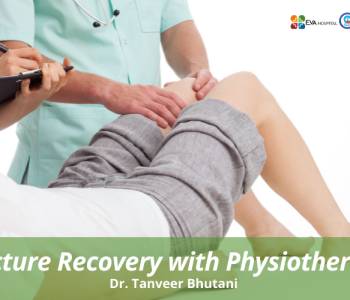 Eva Hospital
Eva Hospital
Fractures Recovery With Physiotherapy
Understanding Fracture and use of Physiotherapy
Physiotherapy is one of the best tools for fracture recovery. It is a detailed care plan that aims at the complete recovery of the patient.
Its gradual and yet consistent process ensures proper recovery and long-term positive effects. A fracture is generally defined as a break in a bone that disrupts its continuity in some way.
Some different types of fractures include open fractures, closed fractures, transverse fractures, oblique fractures, and spiral fractures.
For most of the fracture healing time, fractures are treated through the means of surgery which helps to bring bone alignment back.
Surgery is highly recommended for unstable and complicated fractures. Irrespective of the method being used (open reduction or closed reduction), the bone needs to be immobilized and kept in the proper position. Generally, a cast made of Plaster of Paris or surgical fixation is used for this end.
When Can Be Physiotherapy Introduce?
Physiotherapy can be started as soon as the joint fracture is immobilized. It is indeed one of the most effective treatments for fractures.
In the early phases of healing, Physiotherapy enables the strengthening of unaffected limbs, minimizes joint stiffness around the fractured limbs.
Later, it can also aid in alleviating pain and swelling in unaffected areas through different modalities. This is important for regaining muscle strength and preventing any further unease.
How Is It Useful?
Physiotherapy is useful in healing fractures in the following ways:
- It relieves pain/ minimizes its effect gradually.
- Enables muscle strengthening
- Helps with functional mobility
- Alleviates muscle weakness
- Reduces swelling
- Restoring full mobility
- Reduces stiffness
- Prevents more damage
Treatments
Physiotherapy treatments include pain relief practices, Bracing, soft tissues release, manual therapy, and ancillary muscle strength modalities.
Fracture Physiotherapy also includes maintaining the strength of weak muscles, working on reducing pain as well as swelling, promoting healing, exercises to enhance weight-bearing, and maintaining mobility.
Some other options could be the use of a structured strengthening regime, Ice therapy, and Taping.
Timeline
The majority of fractures heal within 6 weeks but undue stress on the body due to a fracture also either damages or makes other soft tissues vulnerable.
The immobilization in plaster, also adds to joint stiffness and muscle weakness. Based on the severity of the fracture, the physiotherapist advises a course of treatment and may also advise the use of assisted devices in the initial stages.
Further, the patient is advised and taught to engage in some exercises to better overall endurance levels and to make little adjustments for functional mobility.
Also Read: Physical Therapy and Exercises After Knee Replacement Surgery
Fractures often heal properly within 12 weeks at most. However, sometimes there can be a possibility of some complications like nerve damage, tendon ruptures, or ongoing stiffness.
This is where Physiotherapy treatment comes into play, and would certainly allow you to bypass all the potential complications of a fracture.
Dr. Tanveer Bhutani at Eva hospital takes pride in offering great physiotherapy services and would be happy to serve you. While fractures can be nasty and uneasy to live with, the right Physiotherapist at the right time may save you a lot of trouble.